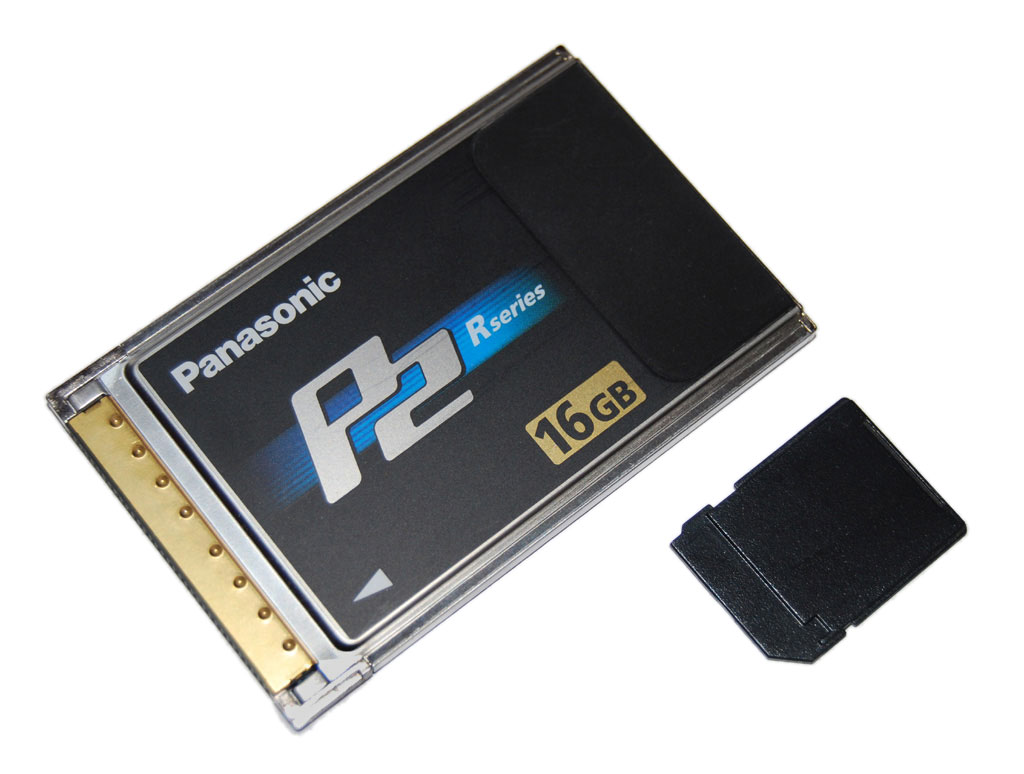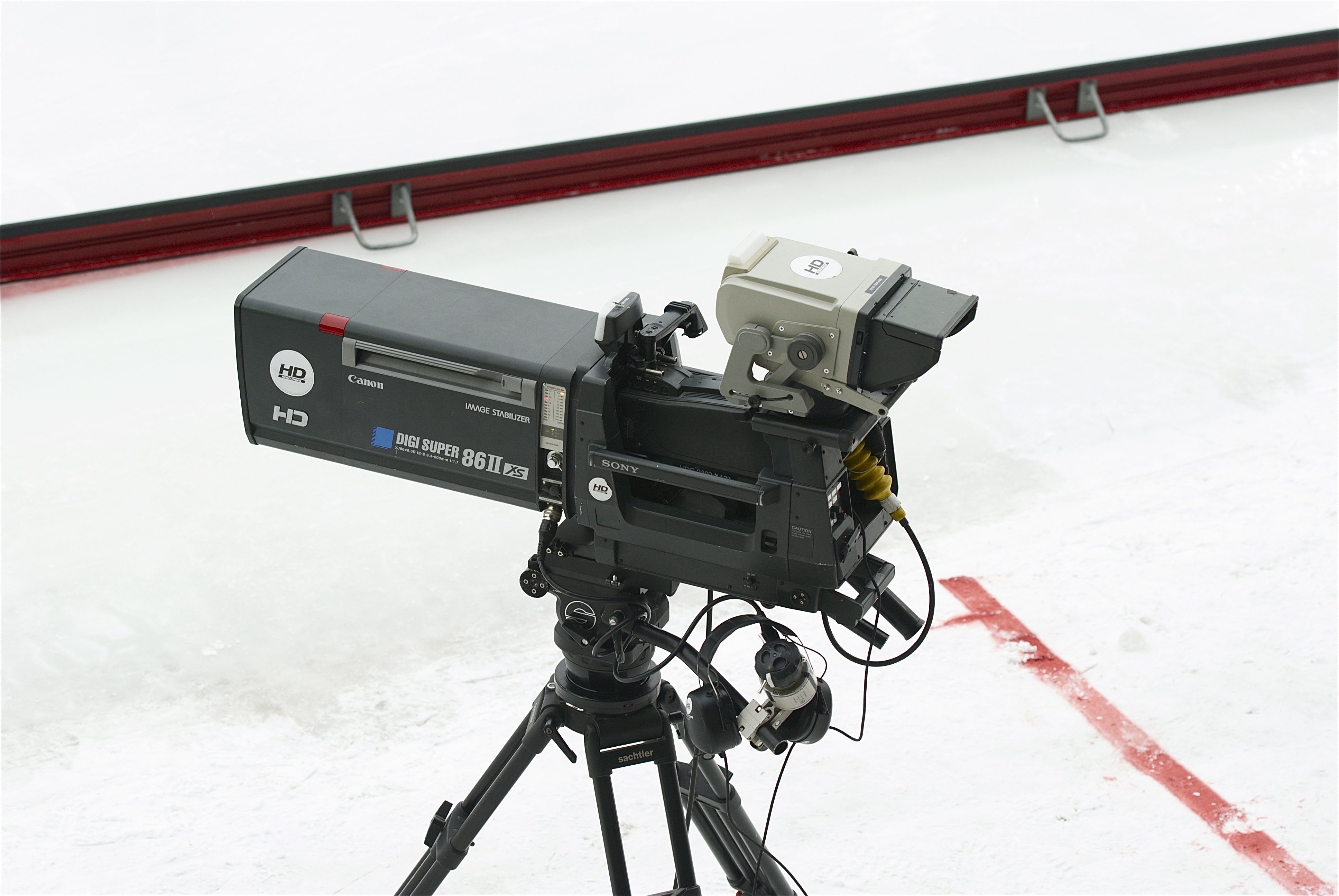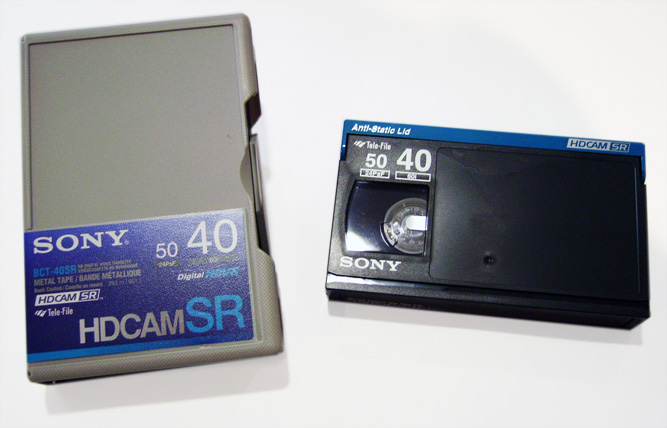|
P2 (storage Media)
P2 (P2 is a short form for "Professional Plug-In") is a professional digital recording solid-state memory storage media format introduced by Panasonic in 2004, and especially tailored to electronic news-gathering (ENG) applications. It features tapeless (non-linear) recording of DV, DVCPRO, DVCPRO25, DVCPRO50, DVCPRO-HD, or AVC-Intra streams on a solid-state flash memory. The P2 card is essentially a RAID of Secure Digital (SD) memory cards with an LSI controller tightly packaged in a die-cast PC Card (formerly PCMCIA) enclosure, so data transfer rate increases as memory capacity increases. The system includes cameras, decks as drop-in replacements for videocassette recorders (VCR), and a special 5.25-inch computer drive for random-access integration with non-linear editing systems (NLE). The cards can also be used directly where a PC card (PCMCIA) slot is available, as in most older notebook computers, as a normal hard disk drive, although a custom software driver must fir ... [...More Info...] [...Related Items...] OR: [Wikipedia] [Google] [Baidu] |
Panasonic P2 Card 16GB 20081214
formerly between 1935 and 2008 and the first incarnation of between 2008 and 2022, is a major Japanese multinational conglomerate corporation, headquartered in Kadoma, Osaka. It was founded by Kōnosuke Matsushita in 1918 as a lightbulb socket manufacturer. In addition to consumer electronics, of which it was the world's largest maker in the late 20th century, Panasonic offers a wide range of products and services, including rechargeable batteries, automotive and avionic systems, industrial systems, as well as home renovation and construction. Panasonic has a primary listing on the Tokyo Stock Exchange and is a constituent of the Nikkei 225 and TOPIX 100 indices. It has a secondary listing on the Nagoya Stock Exchange. Corporate name From 1935 to October 1, 2008, the company's corporate name was "Matsushita Electric Industrial Co." (MEI). On January 10, 2008, the company announced that it would change its name to "Panasonic Corporation", in effect on October 1, 2008, to ... [...More Info...] [...Related Items...] OR: [Wikipedia] [Google] [Baidu] |
Videocassette Recorder
A videocassette recorder (VCR) or video recorder is an electromechanical device that records analog audio and analog video from broadcast television or other source on a removable, magnetic tape videocassette Videotape is magnetic tape used for storing video and usually sound in addition. Information stored can be in the form of either an analog or digital signal. Videotape is used in both video tape recorders (VTRs) and, more commonly, videocasset ..., and can play back the recording. Use of a VCR to record a television program to play back at a more convenient time is commonly referred to as ''timeshifting''. VCRs can also play back prerecorded tapes. In the 1980s and 1990s, prerecorded videotapes were widely available for purchase and rental, and blank tapes were sold to make recordings. VCRs declined in popularity during the early 2000s and in July 2016, Funai Electric, the last manufacturer of them ceased production. History Early machines and formats The h ... [...More Info...] [...Related Items...] OR: [Wikipedia] [Google] [Baidu] |
MicroP2
MicroP2 is a memory card format introduced by Panasonic. The cards were announced in April 2012 and shipped in March 2013. Physically, MicroP2 is a SDXC/SDHC card conforming to UHS-II (Ultra High Speed bus), and can be read by common SDHC/SDXC card readers. It can be used with P2 products using an adapter, though a firmware update A patch is a set of changes to a computer program or its supporting data designed to update, fix, or improve it. This includes fixing security vulnerabilities and other bugs, with such patches usually being called bugfixes or bug fixes. Patche ... is required to use the new media. The first MicroP2 products from Panasonic shipped in April 2013. References {{Panasonic Panasonic products ... [...More Info...] [...Related Items...] OR: [Wikipedia] [Google] [Baidu] |
HVX200
This is a list of Panasonic camcorders. Professional standard definition models (MiniDV) Panasonic AG-DVX100 (2002) Introduced in 2002, AG-DVX100 was Panasonic's first affordable 3CCD Digital data, digital progressive scan camcorder. Equipped with a 10x Leica Dicomar lens, sensor was a 1/3 inch, 470,000 pixel 3CCD. DVX100 boasts better specs and picture quality than its physically larger predecessors like AG-DVC7 or DVC15. Includes 2 native XLR microphone inputs. Two revisions, namely DVX100A and DVX100B, were introduced in 2004 and 2005, respectively. Panasonic AG-DVC30 (2004) Introduced in 2004, AG-DVC30 was a 3CCD prosumer model. Essentially a step-down version of the renowned DVX100a, it is physically more compact, but uses a smaller (1/4 in.) CCD and lacks the true progressive scan mode. Also, XLR microphone input is not included by default; a 2-channel XLR adapter was offered as additional accessory. Features SNS mode - Panasonic's version of Nightshot and OIS - Optical I ... [...More Info...] [...Related Items...] OR: [Wikipedia] [Google] [Baidu] |
Tapeless Camcorder
A camcorder is a self-contained portable electronic device with video and recording as its primary function. It is typically equipped with an articulating screen mounted on the left side, a belt to facilitate holding on the right side, hot-swappable battery facing towards the user, hot-swappable recording media, and an internally contained quiet optical zoom lens. The earliest camcorders were tape-based, recording analog signals onto videotape cassettes. In 2006, digital recording became the norm, with tape replaced by storage media such as mini-HD, microDVD, internal flash memory and SD cards. More recent devices capable of recording video are camera phones and digital cameras primarily intended for still pictures, whereas dedicated camcorders are often equipped with more functions and interfaces than more common cameras, such as an internal optical zoom lens that is able to operate silently with no throttled speed, whereas cameras with protracting zoom lenses commonly throttl ... [...More Info...] [...Related Items...] OR: [Wikipedia] [Google] [Baidu] |
Professional Video Camera
A professional video camera (often called a television camera even though its use has spread beyond television) is a high-end device for creating electronic moving images (as opposed to a movie camera, that earlier recorded the images on film). Originally developed for use in television studios or with outside broadcast trucks, they are now also used for music videos, direct-to-video movies (see digital movie camera), corporate and educational videos, wedding videos, among other uses. Since the 2000s, most professional video cameras are digital (instead of analog) professional video cameras. The distinction between professional video cameras and movie cameras became much smaller as HD digital video cameras with sensors the same size as 35mm movie cameras - plus dynamic range ( exposure latitude) and color rendition approaching film quality - were introduced in the late 2010s. Nowadays, HDTV cameras designed for broadcast television, news, sports, events and other works such as re ... [...More Info...] [...Related Items...] OR: [Wikipedia] [Google] [Baidu] |
Electronic Field Production
Electronic field production (EFP) is a television industry term referring to a video production which takes place in the field, outside of a formal television studio, in a practical location or special venue. ZettlHerbert Zettl, ''Television Production Handbook'', 12th Ed. defines EFP as using "both ENG (electronic news gathering) and studio techniques. From ENG it borrows its mobility and flexibility; from the studio it borrows its production care and quality control. EFP takes place on location (which may include shooting in someone's living room) and has to adapt to the location conditions... Good lighting and audio are always difficult to achieve in EFP, regardless of whether you are outdoors or indoors. Compared to ENG, in which you simply respond to a situation, EFP needs careful planning." Typical applications of electronic field production include awards shows, concerts, major interviews for newsmagazine shows like ''Inside Edition'', ''Extra'' and ''Dateline NBC'', larg ... [...More Info...] [...Related Items...] OR: [Wikipedia] [Google] [Baidu] |
HDCAM
HDCAM is a high-definition video digital recording videocassette version of Digital Betacam introduced in 1997 that uses an 8-bit discrete cosine transform (DCT) compressed 3:1:1 recording, in 1080i-compatible down-sampled resolution of 1440×1080, and adding 24p and 23.976 progressive segmented frame (PsF) modes to later models. The HDCAM codec uses rectangular pixels and as such the recorded 1440×1080 content is upsampled to 1920×1080 on playback. The recorded video bit rate is 144 Mbit/s. Audio is also similar, with four channels of AES3 20-bit, 48 kHz digital audio. Like Betacam, HDCAM tapes were produced in small and large cassette sizes; the small cassette uses the same form factor as the original Betamax. The main competitor to HDCAM was the DVCPRO HD format offered by Panasonic, which uses a similar compression scheme and bit rates ranging from 40 Mbit/s to 100 Mbit/s depending on frame rate. HDCAM is standardized as SMPTE 367M, also know ... [...More Info...] [...Related Items...] OR: [Wikipedia] [Google] [Baidu] |
MiniDV
DV refers to a family of codecs and tape formats used for storing digital video, launched in 1995 by a consortium of video camera manufacturers led by Sony and Panasonic. In the late 1990s and early 2000s, DV was strongly associated with the transition from analog to digital desktop video production, and also with several enduring " prosumer" camera designs such as the Sony VX-1000. DV is sometimes referred to as MiniDV, which was the most popular tape format using a DV codec during this time. In 2003, DV was joined by a successor format called HDV, which used the same tapes but with an updated video codec; HDV cameras could typically switch between DV and HDV recording modes. In the 2010s, DV rapidly grew obsolete as cameras using memory cards and solid-state drives became the norm, recording at higher bitrates and resolutions that were impractical for mechanical tape formats. Additionally, as manufacturers switched from interlaced to superior progressive recording method ... [...More Info...] [...Related Items...] OR: [Wikipedia] [Google] [Baidu] |
Video Tape
Videotape is magnetic tape used for storing video and usually sound in addition. Information stored can be in the form of either an analog or digital signal. Videotape is used in both video tape recorders (VTRs) and, more commonly, videocassette recorders (VCRs) and camcorders. Videotapes have also been used for storing scientific or medical data, such as the data produced by an electrocardiogram. Because video signals have a very high bandwidth, and stationary heads would require extremely high tape speeds, in most cases, a helical-scan video head rotates against the moving tape to record the data in two dimensions. Tape is a linear method of storing information and thus imposes delays to access a portion of the tape that is not already against the heads. The early 2000s saw the introduction and rise to prominence of high-quality random-access video recording media such as hard disks and flash memory. Since then, videotape has been increasingly relegated to archival and simi ... [...More Info...] [...Related Items...] OR: [Wikipedia] [Google] [Baidu] |
Hard Disk Drive
A hard disk drive (HDD), hard disk, hard drive, or fixed disk is an electro-mechanical data storage device that stores and retrieves digital data using magnetic storage with one or more rigid rapidly rotating platters coated with magnetic material. The platters are paired with magnetic heads, usually arranged on a moving actuator arm, which read and write data to the platter surfaces. Data is accessed in a random-access manner, meaning that individual blocks of data can be stored and retrieved in any order. HDDs are a type of non-volatile storage, retaining stored data when powered off. Modern HDDs are typically in the form of a small rectangular box. Introduced by IBM in 1956, HDDs were the dominant secondary storage device for general-purpose computers beginning in the early 1960s. HDDs maintained this position into the modern era of servers and personal computers, though personal computing devices produced in large volume, like cell phones and tablets, rely on ... [...More Info...] [...Related Items...] OR: [Wikipedia] [Google] [Baidu] |
Notebook Computer
A laptop, laptop computer, or notebook computer is a small, portable personal computer (PC) with a screen and alphanumeric keyboard. Laptops typically have a clam shell form factor with the screen mounted on the inside of the upper lid and the keyboard on the inside of the lower lid, although 2-in-1 PCs with a detachable keyboard are often marketed as laptops or as having a "laptop mode". Laptops are folded shut for transportation, and thus are suitable for mobile use. They are so named because they can be practically placed on a person's lap when being used. Today, laptops are used in a variety of settings, such as at work, in education, for playing games, web browsing, for personal multimedia, and for general home computer use. As of 2022, in American English, the terms ''laptop computer'' and ''notebook computer'' are used interchangeably; in other dialects of English, one or the other may be preferred. Although the terms ''notebook computers'' or ''notebooks'' ori ... [...More Info...] [...Related Items...] OR: [Wikipedia] [Google] [Baidu] |

.jpg)







